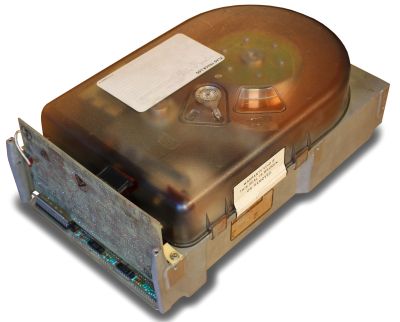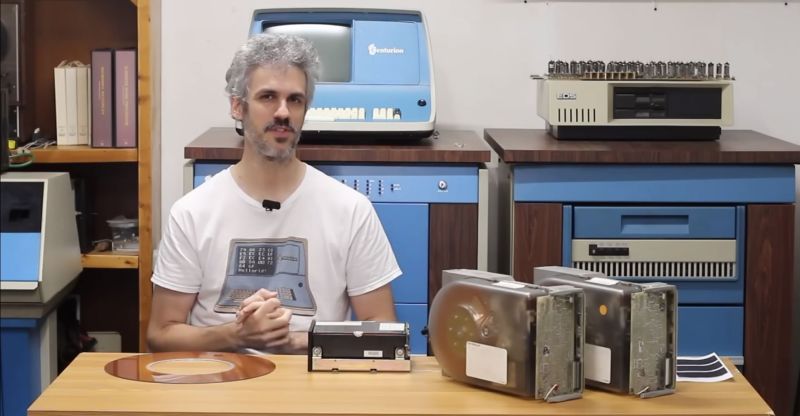As part of the eternal quest within the realm of retrocomputing, storage devices can be one of the most challenging, especially when it comes to firmly obsolete hard drives, such as the CDC Finch drive. This compact 8″ HDD replaced the previous 14″ models with a form factor that was decidedly more portable. These Finch drives being 1980s technology that got run pretty hard before their retirement, it’s little wonder that they’d end up on the repair bench over at [Usagi Electric]

Introduced in the early 1980s, the CDC Model 9410 Finch drive was unlike its 14″ predecessors in that it is a sealed unit, with maintenance-free air filtration. With the 14″ models you’d have both fixed and swappable platters, with far less consideration for dust exposure. This makes these Finch drives more touchy to work on, not unlike HDDs today, and adds to the excitement when repairing one of these old drives.
In this video, two differently broken Finch drives are discussed. Both appear to have an issue on the controller board, with one not responding to communications on the interface, while the other featuring a dead short on the interface pins. The first drive was brought back to life by replacing a dead SN75110 line driver IC, as well as a dead 7818 voltage regulator that was only outputting a sad 0.3 V.
Unfortunately, after half an hour of uptime and in the process of dumping data the drive errored out with a Not Ready, indicating that there are further issues on the controller board to fix. The good news here is that the platters appear to be pretty robust, but the controller boards on these old drives tend to develop issues over the years, something which will be further explored in upcoming videos.

















I really like his restoration of the Centurion and all the information he gives. I hope he advances with the other, drum memory machines, too, exciting technology. I am amazed at how robust they were.
I’m pretty sure the [markup] around names on Hackaday is a cognitive markup, so we know what we’re reading is a name. It’s important when names can be internet pseudonyms, uncapitalised, “foreign”, or in other ways unusual. If you see “this thing by John Smith” you probably know what you’re dealing with, but if you see “this thing by nerfherding” you might not know, so it’s rendered “this thing by [nerfherding]”.
Back in the day, we made a bathroom/hall pass out of one of the platters from one of these in Electronics class when we had a mini-mainframe donated to the department. I got a really nice Lambda power supply out of that machine. Only recently failed.
One of my profs had a collection of head crashed and otherwise F-ed up old school mainframe 24 inch platters on his wall, from disassembled removable packs. Packrat!
A few of them still stunk.
But less then the average undergrad in August, different material burning.
When I was at Edinburgh Uni, the Computer Science machine room had a series of jagged holes in the plasterboard wall at about chest height. Apparently from a hard drive that decided to “let go”.
At home I’ve got a 19″ rack mount 700MB drive, it spins up, but I need to make an interface for it, probably with 5V TTL compatible level shifters and an RPi or similar. Then we can see if there’s any ’80’s pr0n on there!
I really enjoyed Racquel Darrian back in the day…
This video is a fun watch. His excitement and announcer style of describing how to plug in a hard drive and turn it on would make even a non geek want to watch.
OK, you sold me. I’m going to go watch now.
Had one, great paperweight.
The copy/paste errors are a tribute to the recent death of the guy who invented copy/paste. Maybe. That’s my story, and I’m sticking to it.
8″ still beats the 26″ one I had in the 80’s. Size of a portable dishwasher. Needed a slow blow breaker on a 20A circuit (120V) just to get it to fire up!
when I worked here, there was a minimum word count
That’s a “Fixed-Disk Drive” ! 🙂
Looks like it would make for a great SBC case mod.
Back in the 80s i had to rebuild crashed CDC drives we used in our NCR grocery store systems. Long days. However, the inverse of the articles’ title was true for lots of us early computer technogeeks way back when…. “In The 80s… Reviving a Hard Drive”. The worst was the Rodine or “rodent” drives… crashed if you looked at them cross-eyed. Many of us in our computer club at meetings would have stories about long days reformating/reloading/locking out bad sectors. Most of them were from us BBS sysadmins.
rebuilding hard drives, back in the 80’s when they were relatively new?
Hey, I just disassembled one of these today out of curiosity as it was going for scrap! If I can help you with any parts just let me know. 👍🏼